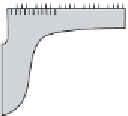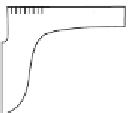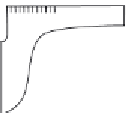Global Positioning System Reference
In-Depth Information
Consider the calipers of figure 3.12. The upper, fixed-length scale di-
vides each unit into tenths. In the case of calipers without a Vernier scale,
there would be only an arrow on the moveable arm to mark the dimension
of the hexagonal bolt being measured, and its size would be read o√ from
the upper scale to the nearest 0.1 unit. With a Vernier scale, which is the
moveable scale shown on the bottom, the dimension can be read with ten
times the accuracy, by aligning the graduation marks on both upper and
lower scales. The trick that Vernier exploited is to space the marks of the
moveable scale by units of 0.09 instead of 0.10. Thus, if the moveable scale
slides a distance of 0.01 unit, the first Vernier mark will align with the first
fixed mark because 0.01 + 0.09 = 0.10. If the moveable scale slides 0.02
unit, then the second Vernier mark will line up with the second fixed mark,
and so on. The point is that the human eye is very good at picking out
aligned marks. In figure 3.12 you will have no di≈culty seeing that the
hexagonal nut is 0.76 unit wide. This ability to pick out lines is sometimes
called
Vernier acuity
; it was exploited to some extent in earlier instruments
of navigation, such as the octant, where a horizon and a star were lined up.
Vernier scales work well only if the graduation marks are spaced very
accurately. Accuracy in the machining of scales came 150 years after Ver-
nier developed his scale. In the 1770s Jesse Ramsden, a maker of mathe-
FIGURE 3.12.
The Vernier scale. Here, modern calipers show how the Vernier scale is
used in practice. The fixed-length scale is at the top and the moveable Vernier scale
underneath. It is easy to see which graduation marks line up. In this case, lengths are
graduated in units (say centimeters) and tenths of a unit: by adding a Vernier scale,
lengths can be measured to hundredths of a unit. Of course, the measurement is
accurate only if the caliper machining is good, with tolerances less than a hundredth
of a unit.




































































































